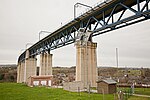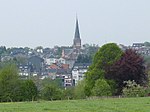Aachen II
1949 establishments in West GermanyAachen (district)Constituencies established in 1949Federal electoral districts in North Rhine-Westphalia

Aachen II is an electoral constituency (German: Wahlkreis) represented in the Bundestag. It elects one member via first-past-the-post voting. Under the current constituency numbering system, it is designated as constituency 88. It is located in western North Rhine-Westphalia, comprising the area of Städteregion Aachen outside the city of Aachen.Aachen II was created for the inaugural 1949 federal election. Since 2017, it has been represented by Claudia Moll of the Social Democratic Party (SPD).
Excerpt from the Wikipedia article Aachen II (License: CC BY-SA 3.0, Authors, Images).Aachen II
Geographical coordinates (GPS) Address Nearby Places Show on map
Geographical coordinates (GPS)
| Latitude | Longitude |
|---|---|
| N 50.716666666667 ° | E 5.9666666666667 ° |
Address
4850
Liège, Belgium
Open on Google Maps









